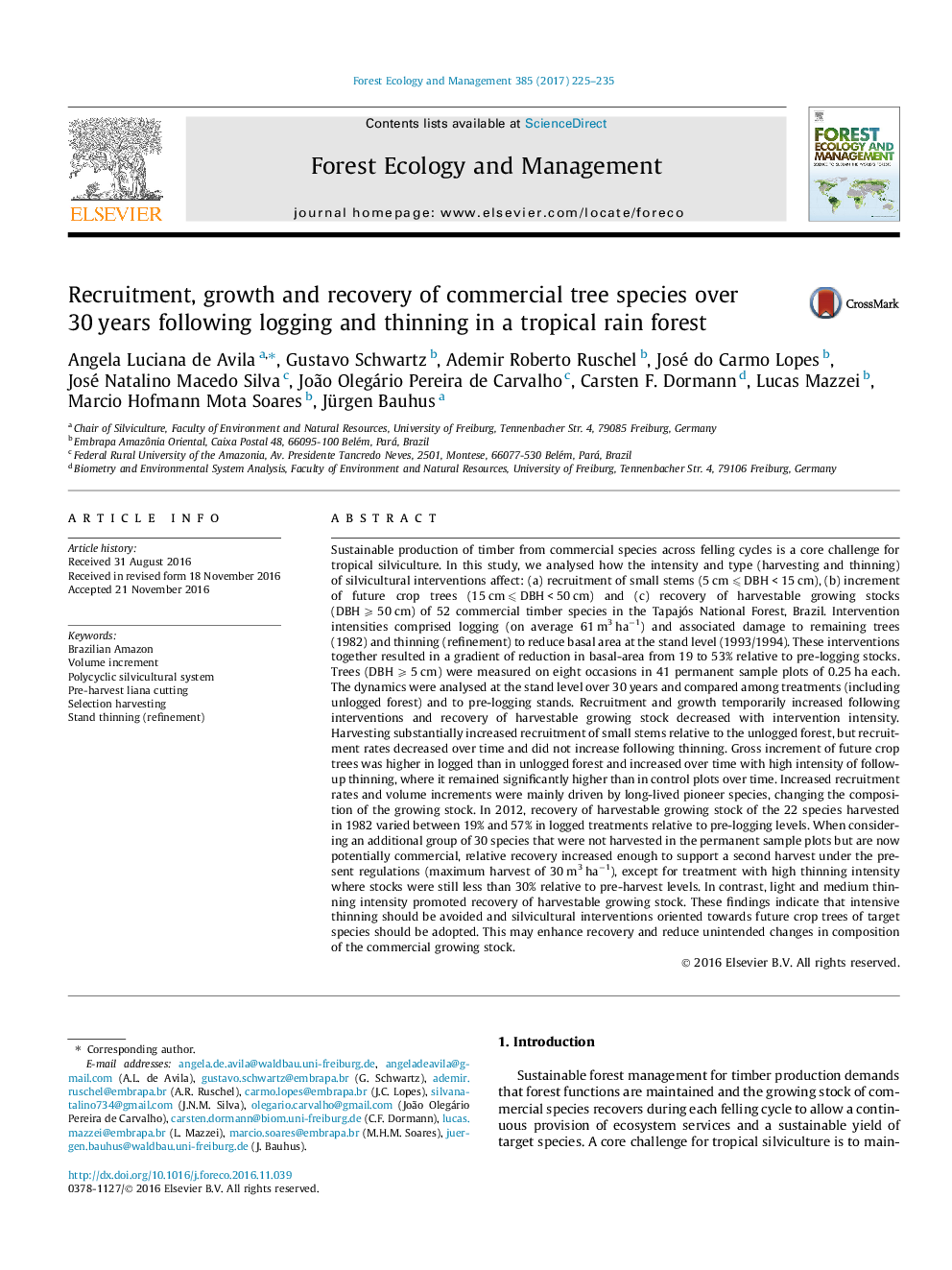| کد مقاله | کد نشریه | سال انتشار | مقاله انگلیسی | نسخه تمام متن |
|---|---|---|---|---|
| 4759581 | 1421373 | 2017 | 11 صفحه PDF | دانلود رایگان |
عنوان انگلیسی مقاله ISI
Recruitment, growth and recovery of commercial tree species over 30Â years following logging and thinning in a tropical rain forest
دانلود مقاله + سفارش ترجمه
دانلود مقاله ISI انگلیسی
رایگان برای ایرانیان
موضوعات مرتبط
علوم زیستی و بیوفناوری
علوم کشاورزی و بیولوژیک
بوم شناسی، تکامل، رفتار و سامانه شناسی
پیش نمایش صفحه اول مقاله

چکیده انگلیسی
Sustainable production of timber from commercial species across felling cycles is a core challenge for tropical silviculture. In this study, we analysed how the intensity and type (harvesting and thinning) of silvicultural interventions affect: (a) recruitment of small stems (5 cm ⩽ DBH < 15 cm), (b) increment of future crop trees (15 cm ⩽ DBH < 50 cm) and (c) recovery of harvestable growing stocks (DBH ⩾ 50 cm) of 52 commercial timber species in the Tapajós National Forest, Brazil. Intervention intensities comprised logging (on average 61 m3 haâ1) and associated damage to remaining trees (1982) and thinning (refinement) to reduce basal area at the stand level (1993/1994). These interventions together resulted in a gradient of reduction in basal-area from 19 to 53% relative to pre-logging stocks. Trees (DBH ⩾ 5 cm) were measured on eight occasions in 41 permanent sample plots of 0.25 ha each. The dynamics were analysed at the stand level over 30 years and compared among treatments (including unlogged forest) and to pre-logging stands. Recruitment and growth temporarily increased following interventions and recovery of harvestable growing stock decreased with intervention intensity. Harvesting substantially increased recruitment of small stems relative to the unlogged forest, but recruitment rates decreased over time and did not increase following thinning. Gross increment of future crop trees was higher in logged than in unlogged forest and increased over time with high intensity of follow-up thinning, where it remained significantly higher than in control plots over time. Increased recruitment rates and volume increments were mainly driven by long-lived pioneer species, changing the composition of the growing stock. In 2012, recovery of harvestable growing stock of the 22 species harvested in 1982 varied between 19% and 57% in logged treatments relative to pre-logging levels. When considering an additional group of 30 species that were not harvested in the permanent sample plots but are now potentially commercial, relative recovery increased enough to support a second harvest under the present regulations (maximum harvest of 30 m3 haâ1), except for treatment with high thinning intensity where stocks were still less than 30% relative to pre-harvest levels. In contrast, light and medium thinning intensity promoted recovery of harvestable growing stock. These findings indicate that intensive thinning should be avoided and silvicultural interventions oriented towards future crop trees of target species should be adopted. This may enhance recovery and reduce unintended changes in composition of the commercial growing stock.
ناشر
Database: Elsevier - ScienceDirect (ساینس دایرکت)
Journal: Forest Ecology and Management - Volume 385, 1 February 2017, Pages 225-235
Journal: Forest Ecology and Management - Volume 385, 1 February 2017, Pages 225-235
نویسندگان
Angela Luciana de Avila, Gustavo Schwartz, Ademir Roberto Ruschel, José do Carmo Lopes, José Natalino Macedo Silva, João Olegário Pereira de Carvalho, Carsten F. Dormann, Lucas Mazzei, Marcio Hofmann Mota Soares, Jürgen Bauhus,